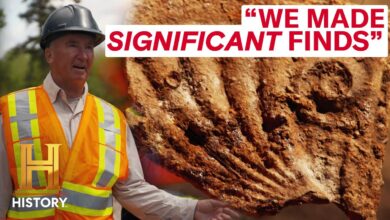The Curse of Oak Island: Knights Templar Secrets Hidden in UK Cave (Season 10)
The Curse of Oak Island: Knights Templar Secrets Hidden in UK Cave (Season 10)

[music playing]
There’s Gretchen.
Hi.
Hello, Gretchen.
[laughs] Nice to see you in person.
NARRATOR: Approximately 2,900 miles away, in the town of Royston, England–
Welcome to Royston, the home of the Royston Cave.
NARRATOR: –Marty Lagina, along with his son, Alex, and Oak Island historian Charles Barkhouse are meeting with author and researcher Gretchen Cornwall.
We’ve got a Roman road going north-south, right out of London.
NARRATOR: Gretchen has invited them to visit Royston Cave, which some researchers believe once served as a sacred meeting place for members of the Knights Templar, the medieval Christian order who are speculated to have buried priceless religious treasures on Oak Island between the 12th and 14th centuries.
As you know, I’ve been studying the Templars for many years.
Yes.
And I think this location is critical to their memory and to the connection to Oak Island, and I would like to show you the symbology in Royston Cave.
- Let’s go have a look.
- Let’s take a look.
Absolutely.
NARRATOR: Founded in 1184, the town of Royston is located in an area that was not only once part of the Roman Empire–
So it’s just through here.
Oh.
NARRATOR: –but is also in a region that later served as a stronghold for the Knights Templar between the 12th and 14th centuries.
Mind your head.
I would not have suspected this, but–
Be careful.
Wow.
NARRATOR: Although the date of Royston Cave’s original construction is unknown, most agree it dates to medieval times.
Wow.
This is really cool.
It really is.
NARRATOR: Its existence was first documented in 1742, when a secret entrance was discovered during construction in the town’s marketplace.
And today, it serves as a major tourist attraction, due to its believed connection to the Templar order.
This entrance is very cool.
Yeah.
Whoa!
Welcome to a Templar initiation chamber.
Wow.
First impression when we get in the cave is that there’s more to this than I thought.
You look around in this cave, and there’s carvings everywhere.
It’s really quite, quite amazing.
The size of it is incredible for something that I assume was dug by hand, right?
Yes.
Absolutely.
Dug by hand.
Like Oak Island.
[chuckles] Good point.
Gretchen, this place is obviously super cool and interesting. Why don’t you just give us some background?
Well, there are some people who believe this is a secret Templar initiation chamber.
My theory is that there was a little structure above here and that it was disguised as a market stall to hide the activity here.
So what you would have done is you would have come down here.
Then you would have come down a small ladder.
And of course, this would have been very dark.
So you would have been taken through with a candle.
Just curious– what’s the dimension across here?
It’s approximately 16 feet.
But as we get into the center, the center circle, it’s more like 13 feet in through there.
There you go.
13 feet.
There it is again.
- Mm-hmm.
That number just keeps popping up.
That was the original diameter of the money pit.
So if we think about Templars as Brothers Without Borders, you would have had, potentially, French Templars here, English, Portuguese.
We know they were here in the area, going back to, easily, the early 1100s.
I mean, I could be easily convinced this was a Templar something.
In fact, I think I am already.
Yep.
Are there connections to Oak Island?
I believe there are.
That image there is what I believe is portrayed on the cross that Gary found.
Dimensionally, that is basically the same thing.
The head is off to the side.
Even one arm of the cross is shorter than the other two.
I think you’re right.
Actually, it is.
- Yeah.
I don’t know– I don’t know if you can see that.
But there’s the prison at Domme.
Yeah.
That is very, very similar.
And you can see, they passed their time by making carvings in the walls to sustain them spiritually.
NARRATOR: In 2017, Rick Lagina, along with his nephews, Alex and Peter, visited a 14th-century prison in Domme, France, where Templar Knights were held captive after the order was disbanded by King Phillip IV in 1307.
There, they were shown a number of Templar carvings, including a very distinct cross.
Whoa!
Whoa, whoa, whoa, whoa!
NARRATOR: Just weeks later, Rick and metal detection expert Gary Drayton found a lead cross on Oak Island with a nearly identical design.
Holy sha-moly, all right.
NARRATOR: A cross that, when scientifically tested, was determined to have originated in Southern France during the 14th century.
Is it possible that Marty, Alex, and Charles have now found a third example in Royston Cave that could serve as more evidence connecting the Knights Templar to the Oak Island mystery?
- It’s three places now.
- Yeah.
I mean, it’s– it’s the lead cross itself, and then Domme, and here.
Yes.
The way that they’re designed, even with the identical tilt of the head–
this is a Templar design.
Yeah.
You know, any of the shared symbology is really interesting.
I think you’ll find even more interesting iconography right here.
Do you see the bricks right there?
Yes.
Up there, on one of the bricks is literally carved “1347.”
I see it now.
And that is literally on Zena’s map.
Incredible.
When I found the map, which is dated 1347, I began to put pieces together.
NARRATOR: In 2016, the late author and researcher Zena Halpern presented the Oak Island team with two maps and a mysterious cipher, suggesting that the Knights Templar had repeatedly visited Oak Island between the 12th and 14th centuries.
Incredibly, one of the maps depicted many well-known landmarks on the Island, such as the swamp, the stone triangle, and what came to be known as the money pit.
It also featured the date of 1347.
Zena’s map, if it’s real, is a super direct connection to Oak Island.
I mean, it is Oak Island.
It is Oak Island.
Yeah.
Here’s the map.
And the date is actually written out here–
[speaking french]
You know, you do have that exact date on Zena’s map, and I think it refers to a voyage in 1347.
Right.
The conjecture would be that’s a commemorative stone.
Says, all right, guys, we’re leaving this place now.
It’s become too dangerous.
They inscribe it, because people do that.
And actually, it’s kind of like a cornerstone, which is where you put such things.
And then, they pack up and go– according to you, to Oak Island, right?
[laughter]
Duc d’Anville Although many Templar Knights were executed after their persecution in France in 1307, many others escaped to areas across Europe, including Portugal, Scotland, and England, and their sacred treasures were never found.
Is it possible that Royston Cave was one of the locations that the Templars secretly used for the safekeeping of valuables before transporting them to Oak Island in 1347?
Anything else here that you think is a connection somehow to Zena’s map?
Yes.
And she is right behind you, Charles.
There?
Yeah.
Do you see a head, a crown, shoulders, a body at the bottom?
And then I believe that is a tail.
And that, I think, could be Melusine from the sixth century, who the Rochefoucaulds claimed as their ancestress.
NARRATOR: In ancient European folklore, the half-fish, half-human goddess known as Melusine was so revered in medieval Europe, that many families believed that they were her descendants.
According to Gretchen’s research, one of these families, whose name also appeared on Zena Halpern’s map, was the Rochefoucaulds.
You believe that is the symbol of the Rochefoucauld family?
Yes.
She is their family crest.
I was in Rochefoucauld, and I took this photo at the chateau itself while I was there.
And she’s at the top here, holding up the marble platform for a bust.
NARRATOR: The Rochefoucaulds were a family of French nobles dating back to the 10th century and are believed to have been connected to the Knights Templar.
I found eight pages of a ship– what looks like a ship’s log.
NARRATOR: In 2017, Oak Island historian Doug Crowell discovered a partial ship’s log describing a secret French Naval mission to hide treasure on a wooded island in Nova Scotia back in September of 1746.
“September 8, it has been agreed that a deep pit be dug and treasure securely buried. The pit to have a secret entrance by a tunnel from the shore.”
NARRATOR: The Admiral in charge of that mission was named Jean-Baptiste Louis Frederick De La Rochefoucauld, also known as the Duc d’Anville.
That’s an interesting find.
Yeah.
If this represents the Rochefoucauld family, then that’s another connection to the map.
Yeah, two, at least two right here.
It’s almost too much to be a coincidence–
Yeah, you need to be thinking about that.
NARRATOR: Is it possible that Gretchen Cornwall has found evidence in Royston Cave that the Knights Templar and, later, members of the Rochefoucauld family both visited Oak Island in order to hide valuables?
If so, could that also explain the high-trace evidence of gold that the team has detected near the garden shaft in the money pit?
Royston Cave delivered.
It was as interesting as Gretchen said.
There are symbols carved in the wall that are similar to Domme.
It actually makes me believe that that cave is older, that maybe that is very ancient and could be significant to Oak Island.
So I’m just going to get some video for Uncle–
Rick will want to see it.
Absolutely.
Especially this.
So this is a really cool place.
Yeah, there’s more here than I ever would have thought.
Thank you for showing us around.
Absolutely.
Thank you so much for being here.
Lead on.
Thank you, sir.








